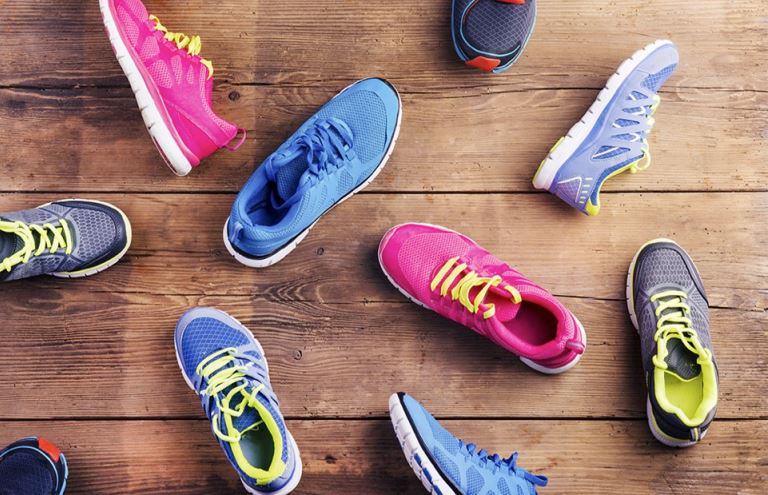
Web Developers
Introduction: The US and European Footwear Markets
In this report, we explore footwear retailing in the US and leading European markets such as the UK, France and Germany. Our analysis considers continuing and emerging trends in footwear retailing. We have observed that trends in the footwear market closely mirror those of the apparel fashion market in that footwear retailers in the US and UK that offer sports-inspired footwear styles are thriving. Consequently, we believe that in the US and in European countries, athleisure and health and wellness trends buoyed footwear sales growth in 2016. Global footwear sales will be driven by the continuation of athleisure and healthy lifestyle trends, the rise of e-commerce, evolving opportunities provided by 3D printing and customization, as well as Amazon’s continued penetration of the apparel and footwear categories. Finally, like apparel retailers, footwear manufacturers are also striving to speed up their supply-chain cycles to bring product from design to market at a faster rate.Athleisure Trend
In line with the athleisure trend, consumers are increasingly seeking designer sneakers and shoes that include elements of sports design. A continued shift to a more active lifestyle is driving sports footwear sales increases, as depicted in the following chart. [caption id="attachment_90332" align="aligncenter" width="419"]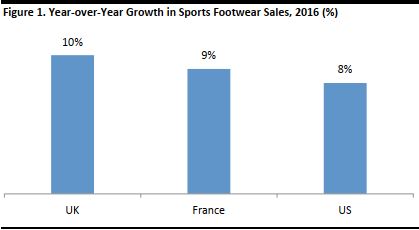 Source: Euromonitor/Fung Global Retail & Technology[/caption]
Sports footwear sales increased at a faster rate than total footwear sales in the UK and the US in 2016.
Source: Euromonitor/Fung Global Retail & Technology[/caption]
Sports footwear sales increased at a faster rate than total footwear sales in the UK and the US in 2016.
- UK: Total UK footwear value sales increased 6.2% year over year in 2016 to reach £10.7 billion ($14.4 billion), according to the Office for National Statistics (ONS). Although this growth rate was stronger than that for clothing, it was the slowest year-over-year growth recorded by the ONS in the past three years.
- US: In the US, total footwear sales increased only 2.8% to reach $76.6 billion in 2016, according to the Bureau of Economic Analysis.
 US
Nike continues to hold the leading market share in US footwear sales in 2016, representing 17.9% of retail value footwear brand sales, according to Euromonitor.
[caption id="attachment_90338" align="aligncenter" width="418"]
US
Nike continues to hold the leading market share in US footwear sales in 2016, representing 17.9% of retail value footwear brand sales, according to Euromonitor.
[caption id="attachment_90338" align="aligncenter" width="418"]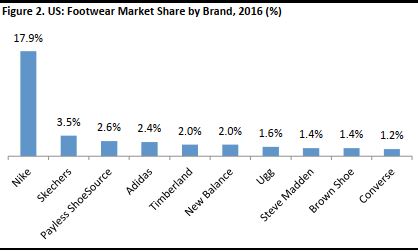 Source: Euromonitor/Fung Global Retail & Technology[/caption]
Europe
In the UK, France and Germany, Nike’s market share is lower.
Source: Euromonitor/Fung Global Retail & Technology[/caption]
Europe
In the UK, France and Germany, Nike’s market share is lower.
 UK: In the UK, Nike and Adidas hold second and third place, respectively.
[caption id="attachment_90351" align="aligncenter" width="419"]
UK: In the UK, Nike and Adidas hold second and third place, respectively.
[caption id="attachment_90351" align="aligncenter" width="419"]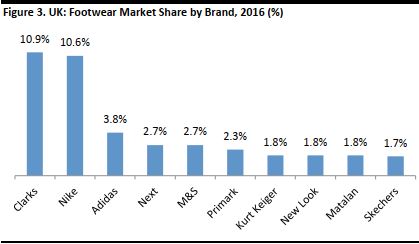 Source: Euromonitor/Fung Global Retail & Technology[/caption]
Source: Euromonitor/Fung Global Retail & Technology[/caption]
 France: In France, Vivarte held the highest market share in the French footwear market at 11% in 2016. This was followed with 7% each by Nike and Adidas, which both registered the highest footwear value market share increases in 2016, according to Euromonitor.
France: In France, Vivarte held the highest market share in the French footwear market at 11% in 2016. This was followed with 7% each by Nike and Adidas, which both registered the highest footwear value market share increases in 2016, according to Euromonitor.
 Germany: In Germany, local player Deichmann held the highest brand market share at 13.1% in 2016, according to Euromonitor. Nike and Adidas followed in second and fourth place, with market shares of 5.7% and 5.0%, respectively, in 2016.
In addition to leading market shares, sales of multinational athletic footwear manufacturers/brands are soaring.
Germany: In Germany, local player Deichmann held the highest brand market share at 13.1% in 2016, according to Euromonitor. Nike and Adidas followed in second and fourth place, with market shares of 5.7% and 5.0%, respectively, in 2016.
In addition to leading market shares, sales of multinational athletic footwear manufacturers/brands are soaring.
- Nike: Global footwear revenues increased 15% year over year at constant currencies in FY16.
- Puma: Footwear sales in FY16 increased 12.6% year over year at constant currencies.
- Adidas: CEO Kasper Rorsted stated on the company’s last earnings results call (1Q17) that the footwear category was still vastly outgrowing apparel in terms of sales. Otherwise, the company does not separately break out sales of footwear and apparel.
- JD Sports Fashion: The UK sports fashion and outdoor goods retailer reported revenues increased by 31% year over year in FY16. Although the company does not break out footwear sales separately from apparel or sporting equipment, we believe that footwear sales trends were in line with the Sports Fashion business.
The Sneaker Culture
Sneakers have become part of everyday style and increasingly more young consumers are following, buying and collecting sneakers. Sneaker reselling has evolved into a billion-dollar industry, boosted by the rise of athleisure and the sneaker “culture.” A footwear stock market called StockX has even been established to allow buyers and sellers to transact at fair market values. Sneaker aficionados are purchasing newly-launched sneakers with the intent of reselling them through consignment shops such as Flight Club and Stadium Goods, apps such as StockX and GOAT and social-media platforms, particularly Instagram and Facebook. The sneaker resale market is growing steadily and expanding and attracting investment.- Stadium Goods, a sneaker and apparel resale marketplace with a New York store raised over $4.6 million in equity funding in January 2017.
- GOAT, an app dedicated to reselling sneakers raised $25 million in funding in February 2017.
Connected/Smart Footwear
Footwear manufacturers and retailers see commercial potential in activity monitoring and smart, connected footwear.- Under Armour: The sportwear brand launched its first smart shoe models in February 2017. The shoes provide runners with automatic tracking capabilities and insights on muscular fatigue. Under Armour plans to double the number of connected footwear models it offers. The three smart shoe models will retail for $140–$160.
- Nike: The company’s self-lacing sneakers apparently generated a strong response from athletes and consumers. The trainers use cables and pressure sensors to determine how tightly they need to be laced.
 Source: news.nike.com[/caption]
Source: news.nike.com[/caption]
Speeding Up Supply Chains
Like fast-fashion apparel retailers, footwear retailers such as Nike and Adidas are working on speeding up their supply-chain cycles to reduce design-to-market timelines.- Nike: The Express Lane is a Nike initiative that revolves around manufacturing and supply-chain speed. The initiative focuses on restocking product more rapidly according to consumer demand, based on sell-through data insight, as well as increasing the speed of creating new products from scratch and bringing them to market. The whole end-to-end process is being cut in half from six months on average to three months or less. Nike believes the customer wants shoes that combine performance and style. Nike is also using more advanced automation technologies, localizing sourcing for faster material lead time. The company is already seeing a positive gross margin impact and we expect that to continue to accelerate.
- Under Armour: Under Armour is also working on speed to market and reducing timeframe of design to market cycles.
3D Printing
Major sportswear brands are adopting 3D printing technology in footwear production. Nike, New Balance and Under Armour have all launched limited editions of 3D printed footwear, whilst Adidas plans to roll out its 3D printed shoes. Footwear retailer DSW, also launched a pop-up store featuring custom 3D printed footwear company Feetz. [caption id="attachment_90361" align="aligncenter" width="411"] Source: feetz.com[/caption]
It typically takes about 9–18 months to produce footwear from conceptualizing a new design to store shelves. 3D printing technology could shorten the time period to just 3–6 months.
In the medium to long term, the innovation of 3D printing will mean the ability to manufacture new products that previously would have been impractical to produce, as well as a shift to move manufacturing closer to customer markets.
Source: feetz.com[/caption]
It typically takes about 9–18 months to produce footwear from conceptualizing a new design to store shelves. 3D printing technology could shorten the time period to just 3–6 months.
In the medium to long term, the innovation of 3D printing will mean the ability to manufacture new products that previously would have been impractical to produce, as well as a shift to move manufacturing closer to customer markets.
- Zalando is thinking about introducing 3D printing for smaller and medium-sized fashion labels, as it would be especially economically beneficial to use the technology to reprint top-selling trainers.
- Adidas is already building 3D-printing factories, called “Speedfactories” in Germany and Atlanta where it will be able to produce goods on demand. Adidas has not stated how much its 3D printed shoes will cost, only that they will be priced as a “premium” product. Adidas expects to have shipped about 5,000 pairs of 3D printed sneakers by the end of 2017 and over 100,000 by the end of 2018.
- Nike has stated that its shoes could one day be 3D printed in-store or even at home.
Customization
Footwear retailers are showing strong interest in 3D printing technology, as this innovative technology can help not only to speed up production, but also allow them to capitalize on the need for customization. Customization is key for footwear, due to the nature of the product, consumer expectations for a perfect fit and demand for functionality.- Under Armour is also working on sneaker personalization, with customization capabilities for consumers to be able to build their footwear.
E-commerce
E-commerce growth in footwear is increasing rapidly. The UK had the highest internet retailing footwear penetration at 27% in 2016, according to Euromonitor. [caption id="attachment_90363" align="aligncenter" width="413"]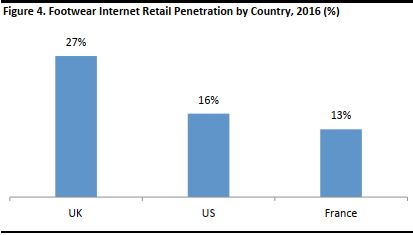 Source: Euromonitor/Fung Global Retail & Technology[/caption]
Source: Euromonitor/Fung Global Retail & Technology[/caption]
- According to a survey conducted by Proper Insights & Analytics in July 2016, US respondents indicated that Amazon was the most shopped retailer for footwear.
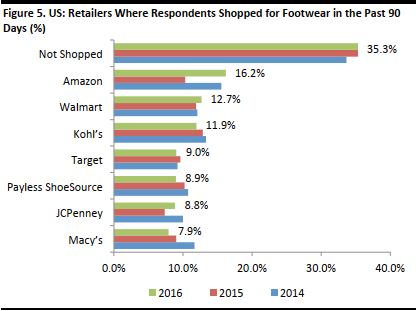 Surveys carried out in July of each year
Surveys carried out in July of each year Survey Base: 6,809 adults aged 18+
Source: Prosper Insights & Analytics [/caption] Amazon’s total shopper penetration rates are boosted in particular by millennials: almost one-quarter of US millennials had shopped at Amazon for shoes in the 90 days prior to the latest survey. Target sees a similar jump for millennials, but the other leading retailers see more even participation rates across age groups. [caption id="attachment_90366" align="aligncenter" width="416"]
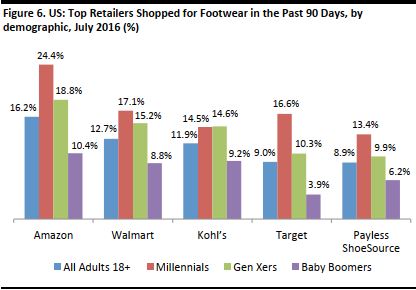 Millennials defined as those born between 1983 and 1998; Gen Xers defined as those born between 1965 and 1982; Baby Boomers defined as those born between 1946 and 1964. Survey Base: 6,809 adults aged 18+ Source: Prosper Insights & Analytics [/caption]
Millennials defined as those born between 1983 and 1998; Gen Xers defined as those born between 1965 and 1982; Baby Boomers defined as those born between 1946 and 1964. Survey Base: 6,809 adults aged 18+ Source: Prosper Insights & Analytics [/caption]
- Amazon has launched private-label footwear lines such as the men’s private-label dress shoe brand Franklin & Freeman. In 2017, Amazon began trialing its first private-label fashion ranges specifically for the UK market—although these do not yet include footwear. More private-label footwear lines could follow.
- Amazon purchased a 3D startup focused on shoe fitting called Shoefitr in 2015.
- Amazon Fashion announced the launch of a dedicated sneaker store of 2,500 brands on its India platform, including top sneaker brands such as Vans, Converse, Adidas, Puma, Reebok, New Balance, Fila and Asics among others.
- ShoeBuy’s online catalogue offers shoes from 800 footwear and clothing brands. ShoeBuy was founded in 1999 in Boston as one of the first online sellers of footwear along with Zappos.
Product Innovation is Key
Footwear giants such as Nike and Adidas have a strong medium- and long-term product-innovation pipeline.- Innovative features/materials: Product innovation areas include new cushioning, lightweight performance materials and digitally-integrated products. Designers and retailers, such as Adidas, are also experimenting with new models and styles produced out of innovative and sustainable fabrics such as recycled ocean plastic.
- Collaborations with designers: Sportswear giants Nike, Adidas and Puma continue to collaborate with high-profile designers such as Alexander Wang and Stella McCartney, as well as artists such as Kanye West and a variety of athletes.
Key Takeaways
- The athleisure trend is strengthening underlying demand for footwear. Consumers are seeking to incorporate sport-styled designs into their everyday wardrobe.
- Trends in the footwear market closely mirror those in the apparel fashion market. Specialty footwear retailers in the UK and the US that offer more sports-inspired footwear styles are thriving. Consequently, in the US and in European countries, athleisure and health and wellness trends buoyed footwear sales growth in 2016.
- The global footwear market will be shaped by the continuation of athleisure and healthy lifestyle trends, the rise of e-commerce, the evolving opportunities provided by 3D printing and customization, as well as Amazon’s continued penetration of the apparel and footwear categories.